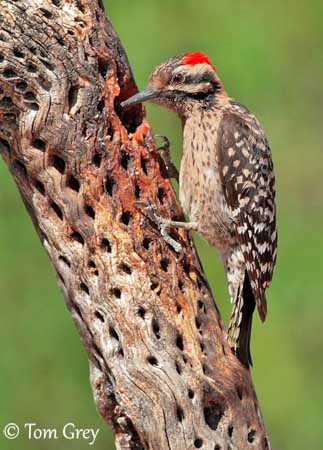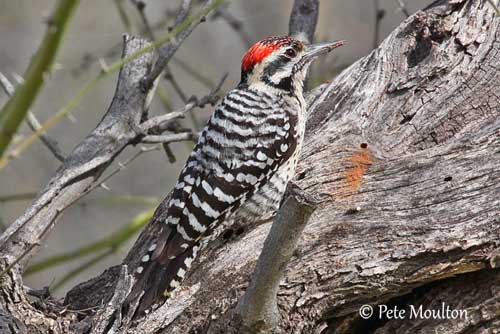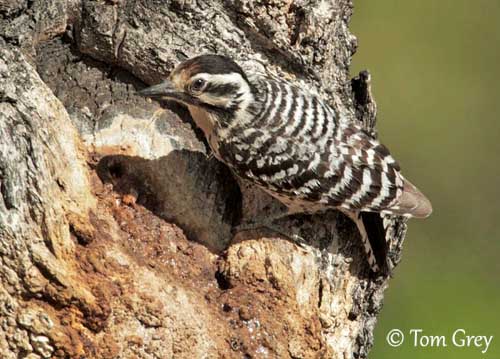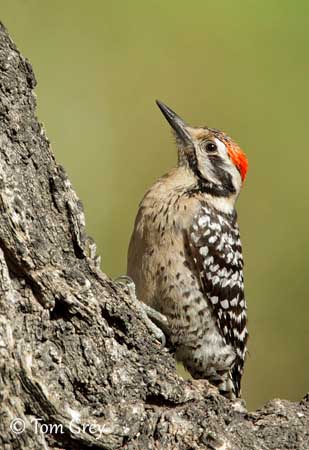
Ladder-backed Woodpecker
Picoides scalaris
Piciforme Order – Picidae Family
BIOMETRICS:
Length: 16-18 cm
Weight: 21-48 g
LONGEVITY: Up to 4 years
DESCRIPTION:
The Ladder-backed Woodpecker has black-and-white barred back and spotted sides. Face and underparts are slightly buffy or greyish. We can see black lines on the face, behind eyes, crossing cheeks and joining base of beak.
The male has red crown and black forehead. Wings are black spotted with white. Undertail coverts are black and white. Tail feathers are stiff to help it for climbing. Tail is black.
The bill is blackish. Eyes are dark. Legs and zygodactylic feet are greyish.
The female lacks red crown, she has black cap.
Juveniles have red on crown, but less extensive than adult male.
Fr: Pic arlequin
All : Texasspecht
Esp : Pico Mexicalo
Ital : Picchio arlecchino
Nd : Ladderspecht
Sd : Bandryggig hackspett
Photographers :
Tom Grey
Tom Grey's Bird Pictures
Pete Moulton
Pete Moulton Photography
Text by Nicole Bouglouan
Sources :
HANDBOOK OF THE BIRDS OF THE WORLD Vol. 7 by Josep del Hoyo-Andrew Elliott-Jordi Sargatal – Lynx Edicions – ISBN: 8487334377
FIELD GUIDE TO THE BIRDS OF NORTH AMERICA - National Geographic Society - ISBN: 0792274512
A GUIDE TO THE BIRDS OF MEXICO AND NORTHERN CENTRAL AMERICA by Steve N. G. Howell, Sophie Webb - Oxford University Press - ISBN: 0198540124
All About Birds (Cornell Lab of Ornithology)
Animal Diversity Web (University of Michigan Museum of Zoology)
What Bird-The ultimate Bird Guide (Mitchell Waite)
Wikipedia (Wikipedia, The Free Encyclopedia)
It forages on trunks and limbs on trees. It feeds on beetle larvae on small trees; it also eats cactus fruits, and forages on the ground for insects.
Ladder-backed Woodpecker moves by walking, hopping, and climbing on trunks.
This species doesn’t migrate.
Ladder-backed Woodpecker may hybridize with Nutall’s Woodpecker, when their range overlaps.
Male and female sleep in separate cavities, but male mates with only one female.
This species has a tree drumming pattern sporadic and inconsistent, and often when they are in small groups of three to four birds.
FLIGHT:
Ladder-backed Woodpecker has a swift and undulating flight.
REPRODUCTION:
Ladder-backed Woodpecker excavates nest cavities in cactus (Yucca’s dead flowers stalk, or in Joshua tree) living in desert. It also may nest in riparian areas at the edge of the desert, and it nests in snags of Cottonwoods, Willows and Mesquites. Nest is usually situated at about 2 to 30 feet above the ground.
Female lays 4 to 5 white eggs. Incubation lasts about 13 days, shared by both parents. Chicks hatch altricial. Both male and female take care for young after hatching, until they fledge.
DIET:
Ladder-backed Woodpecker feeds mainly on insects, wood-boring beetles and other insects such as caterpillars and ants. It also feeds on fruit of cactus.
PROTECTION / THREATS / STATUS:
Ladder-backed Woodpecker eats beetle larvae and helps to pest control, because this larva eats maturing fruits.
It has some predators, such as snakes visiting nests, and raptors which regularly attack Woodpeckers.

VOICE: SOUNDS BY XENO-CANTO
Ladder-backed Woodpecker’s call is a crisp “pik”. It also utters a descending whinny and harsh rattle.
HABITAT:
Ladder-backed Woodpecker is common in dry bushland, cactus areas, and desert. It may be often seen in towns and rural areas. It may be found in mangrove swamps in Honduras.
RANGE:
Ladder-backed Woodpecker is resident from south-western United States, and southwards to Honduras; it is found in California, Nevada, Utah, Colorado, Oklahoma and Texas, south into Tropics.
BEHAVIOUR:
Ladder-backed Woodpecker feeds on insects and arthropods, foraging by gleaning, probing, prying and tapping. It also may excavate.


